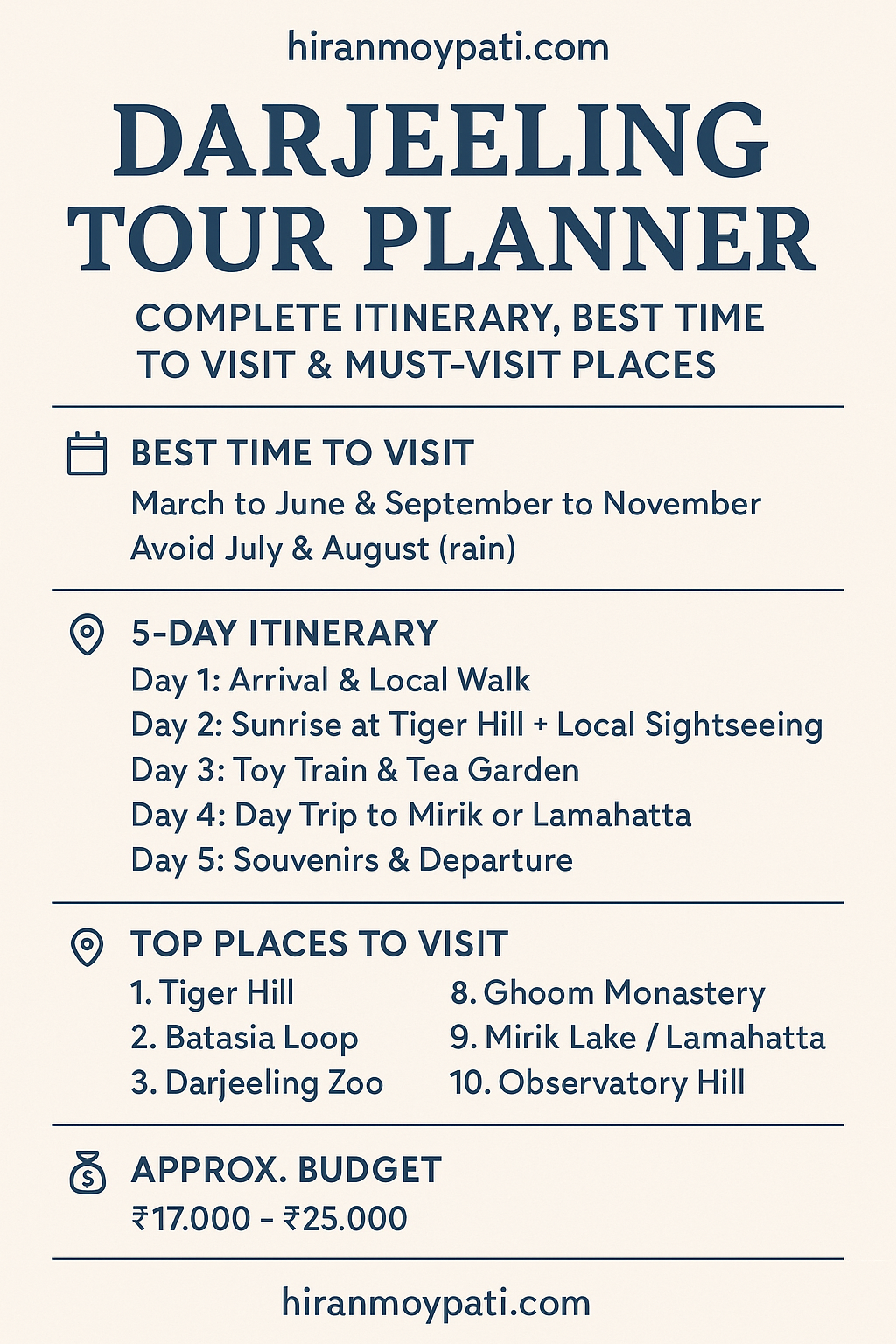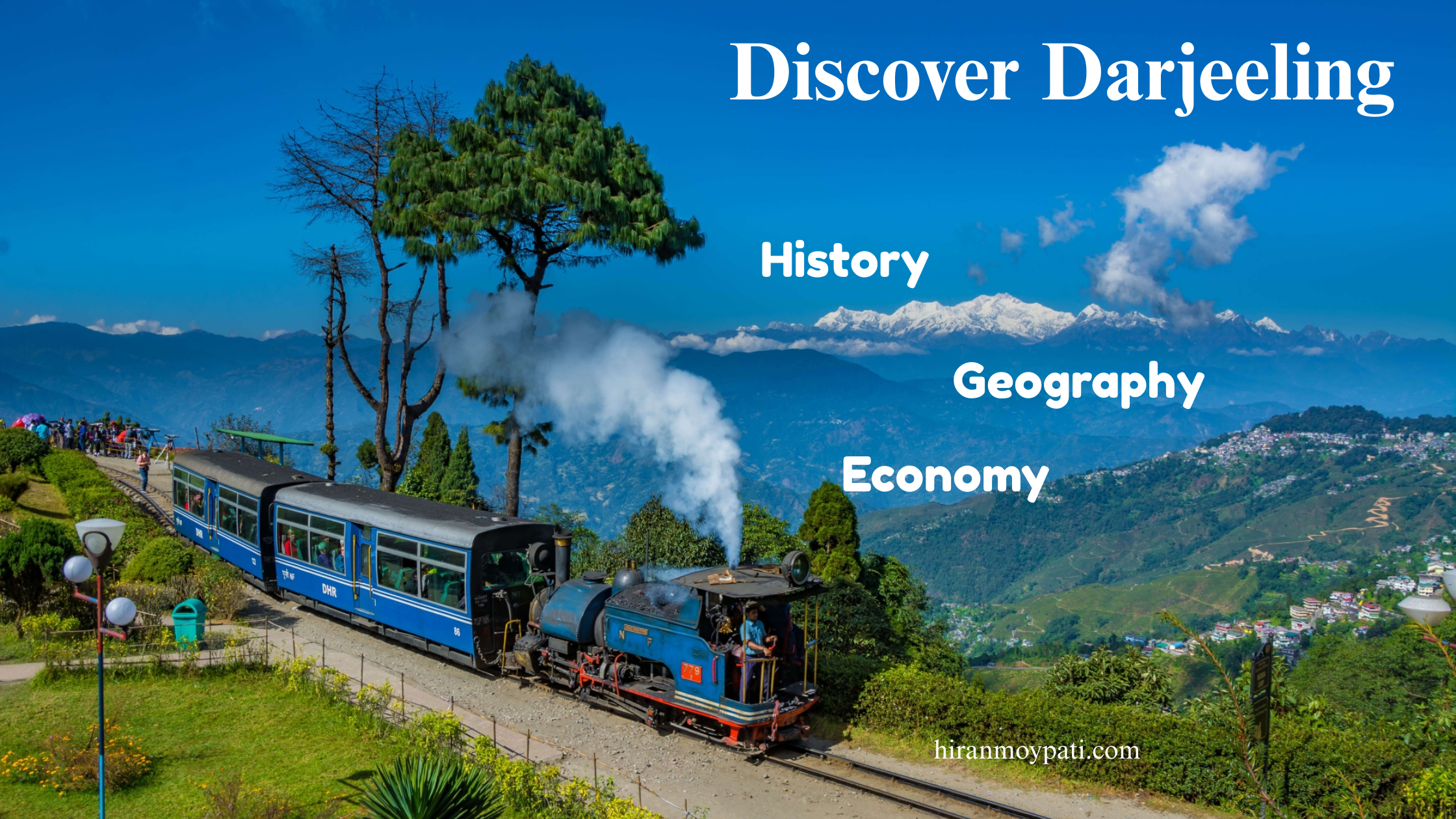Planning a dream trip to Darjeeling? You’re in the right place! Known as the “Queen of the Hills”, Darjeeling offers a magical blend of breathtaking Himalayan views, colonial charm, lush tea gardens, and a peaceful escape from the chaos of city life. Whether you’re a solo traveler, a romantic couple, or a family with kids, Darjeeling promises unforgettable moments.
In this blog, we’ll guide you through:
- The best time to visit Darjeeling
- A day-wise itinerary with estimated costs
- The top attractions
- Travel tips, food recommendations, and more!
🗓️ Best Time to Visit Darjeeling
| Season | Months | Highlights |
|---|---|---|
| Spring | March – April | Clear skies, blooming rhododendrons |
| Summer | May – June | Pleasant weather, ideal for sightseeing |
| Autumn | September – November | Crisp air, best mountain views |
| Winter | December – February | Snow in nearby areas, chilly weather |
| Avoid Monsoon | July – August | Heavy rain and landslides possible |
✅ Best time overall: March to June & September to November
❌ Avoid: July & August (due to rain and roadblocks)
🧳 How to Reach Darjeeling
- By Air: Nearest airport is Bagdogra (IXB) – 70 km from Darjeeling.
- By Train: Nearest major railway station is New Jalpaiguri (NJP).
- By Road: Shared taxis or private cabs available from Siliguri, NJP or Bagdogra.
🚗 Taxi Fare (One-way): ₹2,000 – ₹3,000 (private), ₹300 – ₹400 (shared)
🗺️ 5-Day Darjeeling Itinerary with Budget
Let’s plan a 5-day Darjeeling tour including sightseeing, food, and lodging for a comfortable trip.
✨ Day 1: Arrival & Local Walk
- Arrive at NJP/Bagdogra → Travel to Darjeeling (3-4 hrs)
- Check-in at hotel
- Evening walk to Mall Road, enjoy coffee at Glenary’s
- Explore Chowrasta and buy souvenirs
💰 Approx. Cost:
- Taxi: ₹2,500
- Hotel: ₹1,500 (budget) – ₹4,000 (mid-range)
- Food: ₹400
🌄 Day 2: Sunrise at Tiger Hill + Local Sightseeing
- 4 AM: Drive to Tiger Hill to watch the sunrise over Kanchenjunga
- On the way back, visit:
- Batasia Loop & War Memorial
- Ghoom Monastery
- Post-breakfast:
- Darjeeling Zoo & Himalayan Mountaineering Institute
- Tenzing Rock
- Peace Pagoda (Japanese Temple)
💰 Approx. Cost:
- Cab (half day): ₹1,500
- Entry tickets: ₹300
- Food: ₹500
🚂 Day 3: Toy Train & Tea Garden
- Ride the Darjeeling Himalayan Railway (UNESCO World Heritage Toy Train) – Joy Ride (Darjeeling to Ghoom and back)
- Visit Happy Valley Tea Estate – Tea garden walk and tasting session
- Evening: Sunset from Observatory Hill
💰 Approx. Cost:
- Toy Train: ₹1,000 (1st Class), ₹600 (2nd Class)
- Tea Garden entry: ₹200
- Food + Misc: ₹600
🏞️ Day 4: Day Trip to Mirik or Lamahatta
Option A: Mirik Lake – Serene lake, boating, pine forests
Option B: Lamahatta Eco Park – Romantic nature walk, forest picnic
- En route: Stop at Jorpokhri, Simana View Point, Indo-Nepal border
💰 Approx. Cost:
- Cab (full day): ₹3,000 (can be shared among 4 people)
- Food: ₹500
- Entry: ₹100
🛍️ Day 5: Souvenirs & Departure
- Visit Bhutia Market and Tibetan Refugee Center for shopping
- Try local momo, thukpa one last time!
- Depart for NJP/Bagdogra
💰 Approx. Cost:
- Shopping: ₹1,000 (optional)
- Taxi to NJP: ₹2,500
🏨 Where to Stay in Darjeeling?
| Category | Budget Range (Per Night) | Suggestions |
|---|---|---|
| Budget | ₹1,000 – ₹1,800 | Revolver, Smriya Homestay |
| Mid-range | ₹2,000 – ₹4,000 | Dekeling Hotel, Sinclairs Darjeeling |
| Luxury | ₹5,000+ | Mayfair Darjeeling, Elgin Hotel |
🌟 Top 10 Must-Visit Places in Darjeeling
- Tiger Hill – Sunrise and Himalayan peaks
- Batasia Loop – Scenic train spot
- Darjeeling Zoo – Red pandas and snow leopards
- Himalayan Mountaineering Institute (HMI)
- Peace Pagoda & Japanese Temple
- Darjeeling Toy Train (Joy Ride)
- Tea Gardens (Happy Valley)
- Ghoom Monastery
- Mirik Lake or Lamahatta
- Observatory Hill & Mahakal Temple
🍽️ What to Eat in Darjeeling?
- Momo (steamed dumplings)
- Thukpa (Tibetan noodle soup)
- Darjeeling tea (must try!)
- Sael Roti, Aloo Dum
- Bakeries like Glenary’s, Keventers
💰 Estimated Total Budget (Per Person)
| Category | Budget (Approx) |
|---|---|
| Travel (to & fro NJP) | ₹5,000 |
| Hotel (4 nights) | ₹6,000 – ₹12,000 |
| Food | ₹2,000 – ₹3,000 |
| Sightseeing & Entry | ₹2,500 – ₹4,000 |
| Miscellaneous/Shopping | ₹1,500 |
| Total | ₹17,000 – ₹25,000 |
🎒 Pro Tip: Traveling in a group will reduce cab & hotel costs significantly!
✅ Travel Tips
- Carry light woolens in summer, heavy jackets in winter
- Book the toy train and hotels in advance during peak season
- Use local shared taxis if on a tight budget
- Respect the local culture and environment
📸 Final Thoughts
Darjeeling is not just a destination – it’s an experience wrapped in misty hills, colonial charm, soulful tea, and unmatched serenity. With this planner, you’re all set to have a well-organized, memorable trip that balances comfort, exploration, and budget.
If you need help booking packages or a custom itinerary, feel free to contact us at hiranmoypati.com – we’d be happy to assist you!
🔗 Stay tuned for more travel guides, photography tips, and itineraries right here on hiranmoypati.com.
📷 Follow us on Instagram @hiranmoy_pati for travel stories and reels!






